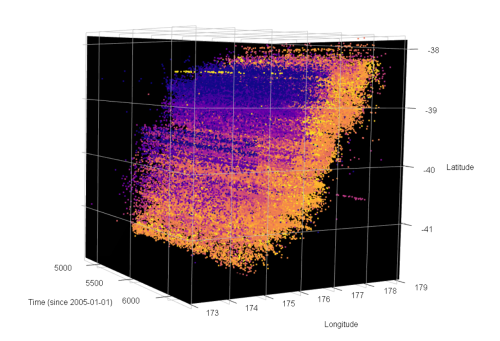
Researchers investigate models for Hikurangi earthquake forecasting

Researchers are putting earthquake forecasting models under the microscope in their latest research, Forecasting future megaquakes on New Zealand’s biggest fault: the Hikurangi Subduction Zone, led by the University of Otago.
This is the first step in the three-year Smart Ideas project, funded by the Ministry of Business, Innovation, and Employment. The goal of which is to create a new model to better understand the future of the Hikurangi Subduction Zone.
The team have examined five existing statistical models used for earthquake forecasting and tested them using a worldwide catalogue of past earthquakes.
The findings from this work, reported in the prestigious Nature Communications journal, suggest that there is no universal model for forecasting large earthquakes.
“For about half of the data, the single ‘best’ model changes when the last event was removed from the catalogue, emphasizing that using one, single ‘best’ model ignores the potential for model uncertainty,” said project Science Lead, University of Otago Associate Professor Ting Wang.
Project Impact Lead, University of Otago Professor Mark Stirling said: “What we found was, nature is still the boss. No one model performed better than another in terms of accuracy, nature is still unpredictable and we must consider the inherent uncertainties in earthquake forecasting.”
Forecasting large earthquakes along active faults is crucial for seismic hazard assessment, and aids in emergency preparedness and risk reduction. However, this relies on statistical models and that will always come with uncertainty.
As the project enters its second year, the team will continue to explore earthquake forecasting, but these initial results underscore the importance of not favouring one model over others, and instead considering other models or a model-averaging approach.
Once a model has been developed, the team will utilise it to explore the relationship between seismic swarms and slow slip events, and ultimately what these processes mean for major earthquakes.
University of Otago PhD student, Jessica Allen, said her research focuses on statistical methods to improve the detection of seismic swarms from the Hikurangi Subduction Zone. She is supervised by Associate Professor Wang, Professor Mark Bebbington (Massey University) and Dr. Calum Chamberlain (Victoria University of Wellington).
Seismic swarms, sometimes called earthquake swarms, are a series of many, similar magnitude earthquakes clustered close together in time and space. Unlike aftershocks, where many earthquakes follow one larger event, earthquake swarms are not initiated by one big mainshock.
“While prolonged seismic swarms are often noticed by residents in the affected area, and show up clearly in the earthquake record, smaller swarms can go unnoticed,” said Allen. “These smaller swarms are still an important source of information about the many complex processes underlying the generation of earthquake activity.”
Equipped with a catalogue of earthquake swarms and slow slip events, the team can understand how often the two co-occur, and what features are associated with these events, and how they relate to major earthquakes.
This research will lead to a better understanding of the future earthquake potential of Hikurangi Subduction Zone, which can be used to better inform emergency preparedness and risk reduction.
“Earthquake forecasting from paleoseismic records”, Nature Communications
https://www.nature.com/articles/s41467-024-46258-z
Image: Provided by Jessica Allen, displays earthquake event locations along the Hikurangi Subduction Zone, plotted by time, between 2018 and 2021. Event data provided by Dr Calum Chamberlain.
3 April 2024
Disclaimers and Copyright
While every endeavour has been taken by the East Coast Lab Hikurangi Subduction Zone M9 to ensure that the information on this website is
accurate and up to date, East Coast Lab Hikurangi Subduction Zone M9 shall not be liable for any loss suffered through the use, directly or indirectly, of information on this website. Information contained has been assembled in good faith.
Some of the information available in this site is from the New Zealand Public domain and supplied by relevant
government agencies. East Coast Lab Hikurangi Subduction Zone M9 cannot accept any liability for its accuracy or content.
Portions of the information and material on this site, including data, pages, documents, online
graphics and images are protected by copyright, unless specifically notified to the contrary. Externally sourced
information or material is copyright to the respective provider.
© East Coast Lab Hikurangi Subduction Zone M9 - www.eastcoastlab.org.nz / +64 6 835 9200 / info@eastcoastlab.org.nz
